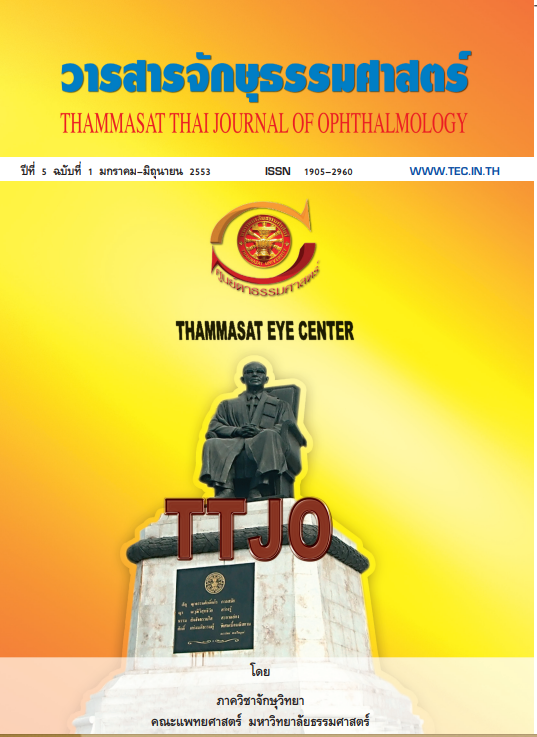ผลการวินิจฉัยโรคเบาหวานขึ้นจอประสาทตา ด้วยเครื่องถ่ายภาพจอประสาทตาชนิดไม่ขยายรูม่านตา โดยไม่ขยายรูม่านตาในศูนย์ตาธรรมศาสตร์
Main Article Content
Abstract
วัตถุประสงค์: เพื่อศึกษาเปรียบเทียบผลการอ่านภาวะเบาหวานขึ้นจอประสาทตาจากภาพที่ถ่ายด้วย เครื่อวถ่ายภาพจอประสาทตาชนิดไม่ขยายรูม่านตาและหลังหยอดยาขยายรูม่านตา
รูปแบบการศึกษา: เป็นการศึกษาแบบ retrospective
วิธีการศึกษา: ศึกษาเปรียบเทียบการแปรผลสภาพถ่ายจอประสาทตาผู้ป่วยเบาหวานที่มารับการตรวจ ในศูนย์ตาธรรมศาสตร์ระหว่างเดือนกรกฎาคม 2551 ถึงเดือนมิถุนายน 2552 ทั้งก่อนหยอดยาขยายรูม่านตาและหลังหยอดยาขยายรูม่านตา โดยจักษุแพทย์ผู้เชี่ยวชาญด้านจอประสาทตาคนเดียวกัน
ผลการศึกษา: ผู้ป่วยเบาหวานที่มาตรวจจอประสาทตาระหว่างเดือนกรกฎาคม 2551 ถึงเดือนมิถุนายน 2552 จำนวน 920 คน (1,840 ตา) ไม่สามารถอ่านผลจอประสาทตาทั้งก่อนและหลังขยายรูม่านตาได้จำนวน 50 ตา สามารถอ่านผลจอประสาทตาได้จำนวน 1,790 ตา พบผลการอ่านภาพ จอประสาทก่อนและหลังหยอดยาขยายรูม่านตาเป็นเบาหวานขึ้นจอประสาทตาในระยะ เดียวกัน 1,145 ตา (63.97%) และผลการอ่านเป็นเบาหวานขึ้นตาระยะต่างกันจำนวน 655 ตา (36.03%) โดยไม่พบเบาหวานขึ้นตา 1,384 ตา (77.32%) และพบเบาหวานขึ้นตาระยะต่างๆ 406 ตา (22.68%)
สรุป: การถ่ายภาพจอประสาทตาจากเครื่องถ่ายภาพจอประสาทตาชนิดไม่ขยายรูม่านตาที่ดี ขึ้น โดยให้ภาพที่สามารถแปลผลการตรวจได้มากขึ้นและภาพจอประสาทตามีความชัดเจนกว่า ภาพถ่ายขณะไม่หยอดยาขยายรูม่านตา
Results of Screening for Diabetic Retinopathy Using Non-Mydriatic Digital Camera in Thammasat Eye Center
Objective: To compare the results of diabetic retinopathy level using a non-mydriatic digital camera before and after dilatation of the pupils.
Study design: Retrospective study
Methods: Patients with diabetes were photographed before and after pharmacological pupil dilation at Thammasat Eye Center using a non-mydriatic digital camera during July 2008 to June 2009. The fundus photograph was classified by the same ophthalmologist.
Results: Fundus colour photographs were taken with a non-mydriatic digital camera in 1,840 eyes of 920 diabetic patients. Fifty eyes were judged ungradable. Good-quality photographs in 1,790 eyes were obtained. The results between before and after dilation were concordant for the same level of diabetic retinopathy in 1,145 eyes (63.97%) and 655 eyes (36.06%) were assessed in different level both for eyes without diabetic retinopathy in 1,384 eyes (77.32%) and with diabetic retinopathy in 406 eyes (22.68%).
Conclusions: The present study demonstrates the efficacy of a diabetic retinopathy screening with non-mydriatic digital camera. Photography through dilated pupils also improved both the quality of the photograph and rate of detection of diabetic retinopathy.
Article Details
References
Zimmet P, Alberti KG, Shaw J. Globaland societal implications of the diabetes epidemic. Nature 2001;414:782-7.
Klein R, Klein BEK, Moss SE, et al. The Wisconsin Epidemiologic Study of Diabetic Retinopathy, III: prevalence and risk of diabetic retinopathy when age at diagnosis is 30 or more years. Arch Ophthalmol 1984;102:527-32.
Bureau of Policy and Strategy. Thailand Health Profile 2005-2007. Nonthaburi: Ministry of Public Health 2008:204-5.
สำนักระบาดวิทยา กรมควบคุมโรค กระทรวงสาธารณสุข. สถิติผู้ป่วยเบาหวานที่มารับบริการ จากสถานบริการสาธารณสุข. กรุงเทพฯ:กระทรวงสาธารณสุข; 2550.
สำนักงานสารสนเทศและประชาสัมพันธ์ กระทรวงสาธารณสุข. ภาวะเบาหวานขึ้นจอประสาทตาwww.moph.go.th/ops/iprg/iprg_new/index.php?page=2
Cai XL, Wang F, Ji LN. Risk factors of diabetic retinopathy in type 2 diabetic patients. Chin Med J 2006;119(10):822-6.
พิทยา ภมรเวชวรรณ, อุบลรัตน์ ปทานนท์. อุบัติการณ์และปัจจัยเสี่ยงในการเกิดเบาหวานขึ้นจอประสาทตาใน รพ.ประจวบคีรีขันธ์. จักษุเวชสาร 2547;18(1):77-84.
Dowse GK, Humphrey ARG, Collins VR, Plehwe W, Gareeboo H, Fareed D, et al. Prevalence and risk factors for diabetic retinopathy in the multiethnic population of Mauritius. Am J Epidemiol 1998;147(5): 448-57.
Chen MS, Kao CS, Chang CJ, Wu TJ, Fu CC, Chen CJ, et al. Prevalence and risk factors of diabetic retinopathy among noninsulindependent diabetic subjects. Am J Ophtalmol 1992;114(6):723-30.
Lim A, Stewart J, Chui TY, Lin M, Ray K, Lietman T, et al. Prevalence and risk factors of diabetic retinopathy in a multi-racial underserved population. Ophthalmic Epidemiol 2008;15(6):4029.
Pradeepa R, Anitha B, Mohan V, Ganesan A, Rema M. Risk factors for diabetic retinopathy in a South Indian Type 2 diabetic population in the Chennai Urban Rural Epidemiology Study (CURES). Diabet Med 2008;25(5):536-42.
จุฑาไล ตัณฑเทิดธรรม, อภิชาติ สิงคาลวนิช, จักรพงศ์ นะมาตร์, อดิศักดิ์ ตรีนวรัตน์, ณัฐวุฒิ รอดอนันต์, โสมนัส ถุงสุวรรณ, วรรณา เอื้อโสภณ. การตรวจจอประสาทตาผู้ป่วยเบาหวานด้วยกล้องถ่ายภาพโดยไม่ขยายม่านตา.J Med Assoc Thai 2007;90:508-12.
C. P. Wilkinson, MD, et al Proposed International Clinical Diabetic Retinopathy and Diabetic Macular Edema Disease Severity Scales, Ophthalmology 2003;110:1677-82.
Thanya Chetthakul, et al. Thailand Diabetes Registry Project: Prevalence of Diabetic Retinopathy and Associated Factors in Type 2 Diabetes Mellitus. J Med Assoc Thai 2006; 89 (Suppl 1): S27-36.
กฤตพร ชินสว่างวัฒนกุล. อุบัติการณ์และปัจจัยเสี่ยงในการเกิดเบาหวานขึ้นจอประสาทตาในโรงพยาบาลสมเด็จพระยุพราชสระแก้ว. โรงพยาบาลสิงห์บุรีเวชสาร 2548;14(1).
วลัยพร ยติพูนสุข. ความชุกและความเสี่ยงของการเกิดภาวะเบาหวานขึ้นจอประสาทตาในจังหวัดแพร่.Journal of Health Science 2008;17(Suppl 2):464-72.
Supachai Supapluksakul, Paisan Ruamviboonsuk, Wansa Chaowakul. The Prevalence of Diabetic Retinopathy in Trang Province Determined by Retinal Photography and Comprehensive Eye Examination. J Med Assoc Thai 2008;91(5):716-22.
รสสุคนธ์ ศรีพัฒนาวัฒน์, เกรียง เจียรพีระพงษ์,พลกฤษณ์ สุขะวัชรินทร์, ทินกรณ์ หาญณรงค์, ศุภสิทธิ์ พรรณนารุโณทัย. การศึกษาความชุกของโรคเบาหวานขึ้นจอประสาทตาในผู้ป่วยเบาหวานชนิดไม่พึ่งอินซูลินของจังหวัดสุโขทัย. วารสารจักษุธรรมศาสตร์ 2550;2(2):6-11.
โยธิน จินดาหลวง. ปัจจัยที่มีผลต่อภาวะเบาหวานขึ้นจอประสาทตาในผู้ป่วยเบาหวานเขตเทศบาลเมืองตาก. Buddhachinaraj Medical Journal 2009;26(1):53-61.


